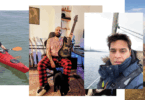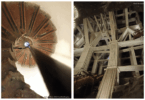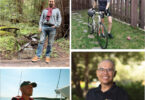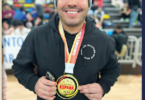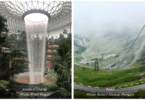by Peter Gantner and Lukas Forstner, OMICRON electronics, Austria
Peter, Julian & Me (Lukas) – We did a rally from Western Europe to Mongolia in a 20-year-old Nissan Micra (1000 cc), crossing countries throughout Europe & Asia. Keep reading to get the story behind.
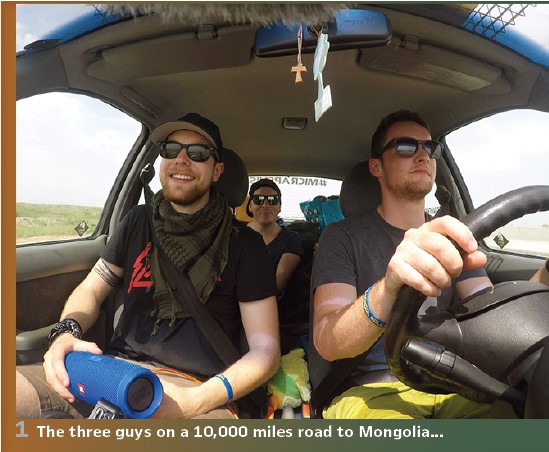
You may wonder why we did something like this. Keep reading to get the story behind.
At that time Peter and I, were both working as Technical Support Engineers at OMICRON electronics – During one of our coffee breaks Peter shared a Video with me, which he came across during a business trip. The video was about some guys doing the Mongol Rally. A rally that has its start in London, England, and the goal is to get to Mongolia, no matter which route. Sounds easy? Well, then better do it with a tiny & old car and an engine as small as it can get. After watching the video, I was curious about the story behind it and started researching the rally and its story.
In the end, our journey started with buying an old car that perfectly suited our requirements and was very affordable at the same time. A 20-year-old Nissan Micra with a 1000 cc engine at a total cost of 900 Euro (after some bargaining with the previous owner).
So, we had a car, which was nice to drive on proper roads, but it was not yet suitable for such kind of adventure. We had to do some adaptions and had to plan a lot, but more about that later…
The emergence of the Mongol Rally: The idea of the Mongol Rally was born in 2001 when two guys named Mr. Tom and Mr. Joolz found themselves staring in awe at their slightly disheveled Fiat 126 wondering what to do with it. After not very long, they came up with the only sensible plan – to drive to the most ridiculous place they could think of. Mongolia was chosen, being 10,000 miles away and including a fine selection of the world’s worst roads it seemed perfect. So, with no changes of clothes, a packet of cheap cigars, and a hunting knife, they set forth. Although they didn’t quite reach Mongolia because of visa and border troubles, they enjoyed themselves so much that they swore to return and try again. From this premise, the great Mongol Rally was born.
This thing became a yearly event with more, and more enthusiasts participating. Some things changed, nowadays the rally is not only about having an adventure and a good time, but also about raising money for a good choice. The rally has two other requirements:
- First, the vehicle’s engine size has a limit of 1200 cc, but ideally it should be under 1000 cc, and
- Second, all the teams are unsupported during their race. So, there will be nobody who comes and helps them in case they have a breakdown in the midst of a desert far away from any civilization.
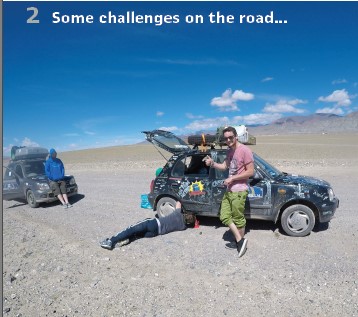
Now it is time to talk about the preparations: As mentioned earlier, the car was bought, but nothing else was planned and organized. After some research, we quickly realized that crossing roughly a third of the world required us to get a bunch of different visas.
This proved to be a little bit more cumbersome than expected especially as some central Asian countries really took their time to issue them.
As we only had about two months in total to organize most of the visas, we ended up applying for two additional passports to get all documents in time. Luckily, everything worked out and we were able to get the last visa on the day before the start of our journey.
To be ready for the challenges on our way, we applied multiple modifications to our car to have space for needed things like spare tires, jerry cans, tents, and clothes for every imaginable weather. A hand-made roof box was one of those modifications.
That’s about it, let the fun begin: In mid-July, we the three guys from Vorarlberg, Austria started off our journey to the start-point of the rally in Goodwood, UK. Already at the very beginning, challenges occurred as our driver-side window broke.
The journey to the official starting line already took us through 5 countries. Arriving in Goodwood Circuit, London we gathered with all the other fellow ralliers and had an awesome Start-Party. There we got to know other guys from our region, whom we met again much later in central Asia, where they did join us and drove in a caravan of some cars.
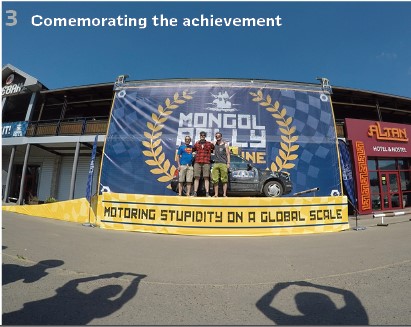
All about the main journey: After quite an eventful start in England, we quickly raced through Europe (while keeping the speed limit). We did so, because of the very good road conditions and to have more time in Central Asia, which turned out to be the real challenge.
In Eastern Europe, we had our first encounter with the local wildlife when we met a brown bear family on the Transfagarasan mountain pass in Romania. Later, on a highway in Bulgaria, we had our second encounter with wildlife, we came across a family of turtles.
Thankfully no animals or cars got hurt during our meetup which could be contributed to the timely reaction of our driver. On the border between Bulgaria and Turkey, we realized that we greatly underestimated the time we needed for border crossings.
Further, we were surprised by the restrictions on goods we were allowed to bring into the country. After skillfully distracting the border guards, we were able to quickly hide the Austrian sausages we brought with us as supply.
However, it still took us many hours to get through all the checkpoints and we only arrived way after midnight in Istanbul. Due to the late hour, we had to approach multiple places until we found somewhere to sleep.
The next main challenge for us was crossing the Caspian Sea via ferry from Baku, Azerbaijan to Turkmenbasy, Turkmenistan. This crossing turned out to be a more exhaustive experience than we ever could imagine.
Firstly, the nonexistence of any timetables made the planning for us a nightmare. However, the fact that the captains had no real experience steering the new ferry they just recently acquired, and the very windy weather, lead to a slight feeling of concern in our group.
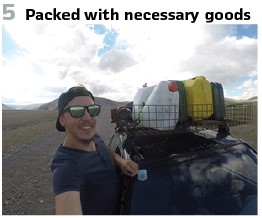
In the end, the crossing took us 38 hours on the boat and an additional 8 hours to get through the Turkmenistan border control. This was a huge stretch compared to the advertised “just a couple of hours.” The border crossing could be compared to the hustle Asterix and Obelix had to get the permit A38 if you know the story, as there were many tedious processes to follow and documents to be filled out.

Due to the long crossing of the Caspian Sea and all the border crossing troubles, we only had two days left of our Turkmenistan visa. This meant that we had to speed through the whole country to leave it in time. Even with considerable time pressure, we did not want to miss out on visiting the “Door to Hell” in the Turkmenistan desert.
This curiosity is a burning natural gas field collapsed into a big hole. Not only the time pressure but also the conditions of the roads, which were filled with potholes made it a real challenge – from the “Door to Hell” to the Uzbek-Border we only managed to get 200 km done in 8 hours, a nice average speed as you can imagine. As we got there quite late, we had to sleep in our cars in front of the border.
On our crossing through the other Stan countries (Uzbekistan & Kazakhstan), the roads did not get vastly better.
We drove through a mix of paved, pothole-filled, and gravel roads.
In Uzbekistan, we struggled to get gas as most cars in Uzbekistan run on LGT. After using our jerry cans for us and our fellow rally mates from Scotland (which we got to know at the Turkmen-Border crossing), we were desperately searching for gas.
Because we weren’t lucky while visiting multiple old gas stations, we ended up purchasing gas in large plastic bottles from a very shady guy we met in a supermarket. It was probably not the best quality gas, but we didn’t care at this moment. Besides all those struggles, we also used the time to celebrate the birthday of Lukas in Uzbekistan and he even got a free cake from the restaurant we dined in.
When we finally arrived in Mongolia, we were greeted by cold and harsh weather. This made the long wait at the border and discussions with the border control guards, due to some disagreements on how passports work, rather unpleasant. After we finally completed our paperwork, we were ready to explore the vast emptiness of the Mongolia highlands.
During our first night in Mongolia, we were able to sleep in an original Mongolian yurt, which was surprisingly conformable.
On the following day, we drove into the Gobi Desert, as a part of our route. After some time, we had to stop, as our car engine was overheating (probably because of the massive amount of dust we swirled up.) We decided to set up our tents for the night and stayed in the desert.
On the next morning, we were greeted with an amazing sunrise. After a short breakfast, we continued our drive further to the east. Later that day we drove through a dried-out canyon.
There it was a challenge to get through knee-deep sand and at some point, and probably to no surprise, we got stuck. While trying to get unstuck we met a golf player and his caddy in the middle of this sand-filled river. They told us that they were trying to hit a golf ball through the whole of Mongolia. At the time of our encounter, they had already covered half of their way. The name of their self-imposed challenge was very fittingly – the last hole.
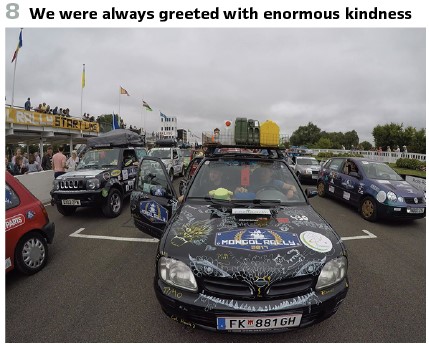
One day after reaching Ulaanbaatar, the Mongolian capital city, we reached the finish line of our rally a few hours after midnight.
We celebrated our victory against all odds with obligatory vodka shots and a honking contest with all the cars that were already at the finish line.
Now when we look back and recapitulate what we learned during this adventure, there are a few things that pop up in our minds:
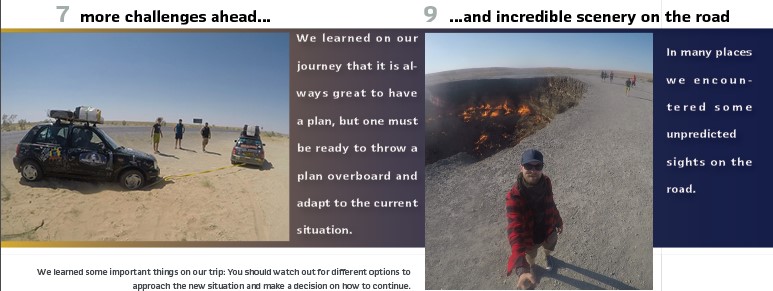
- One major learning was, that no matter where we ended up on our driving days, or how late we knocked on doors, we were always greeted with enormous benevolence, and everyone we met tried to help us as much as they could. No matter if it was by providing us with directions, food, shelter or simply helping us pull our Nissan Micra out of a sand hole.
We met some awesome people during our trip. This willingness to help across the whole 10,000 miles we traveled, showed that we do not need to be afraid of strangers and that we also should always have an eye out for the opportunity in which we can help someone in need.
- Another thing we learned on our journey was that it is always great to have a plan for how to proceed, but one must be ready at any time to throw a plan overboard and adapt to the current (sometimes, very unexpected) situation.
This is also something we did transfer to our daily work, in which also not everything happens as planned and situations change at a fast pace.
In such situations, it is helpful to keep calm and not to panic. After assessing what has happened, you should watch out for different options to approach the new situation, and finally to make a decision on how to continue.
This mindset helped us in overcoming all of the challenges during our trip.
I hope that you had an enjoyable time reading our story and got inspiration for doing a similar kind of adventure.
Biographies:

Peter Gantner joined OMICRON in 2015 as a Technical Support and Application Engineer after graduating in 2014 from the Higher Technical Institute in Rankweil. He completed his bachelor’s degree in engineering & Management at the University of Applied Sciences in 2019. In 2022, he also earned his master’s degree in international management & Leadership. Currently, he is responsible for managing the repair and calibration process, as well as overseeing OMICRON’s international service center network.

Lukas Forstner joined OMICRON in 2011 as a Testfield Engineer after graduating in 2010 from the Higher Technical Institute in Rankweil, Austria. In 2016 he switched positions and is now employed as Technical Support and Application Engineer. In 2020 he took over the lead responsibilities for the Technical Support Team and its Processes. In his off-time he likes to practice sports – He used to play ice-hockey, but at the moment the focus is on Tennis & Climbing.



